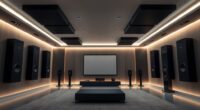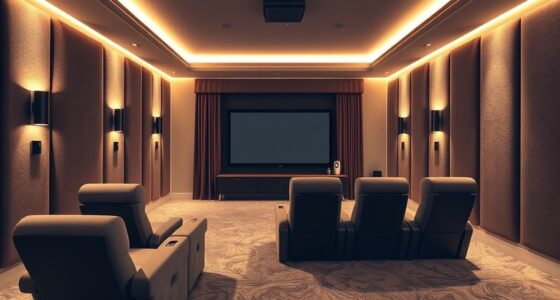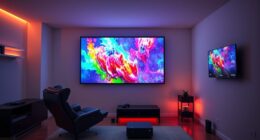To develop an ambient light strategy that truly works, start by evaluating your space and understanding your lighting needs, considering natural light as well as fixture options. Balance natural and artificial sources, choose fixtures that support flexibility, and focus on energy efficiency. Don’t forget to troubleshoot issues and plan for ongoing adjustments to keep your environment inviting and functional. Keep exploring these practical insights to create a lighting plan tailored to your space and style.
Key Takeaways
- Assess space, needs, and maintenance to tailor lighting solutions that are both functional and sustainable.
- Combine natural light with layered artificial lighting for flexibility and optimal ambiance.
- Select fixtures supporting adjustable, control-enabled, and energy-efficient lighting to adapt to changing needs.
- Prioritize proper fixture placement and regular maintenance to ensure consistent, glare-free illumination.
- Incorporate color temperature considerations and smart controls for a harmonious, long-term ambient lighting strategy.
Assessing Your Space and Lighting Needs

Before designing your ambient light strategy, it’s essential to evaluate your space and identify your specific lighting needs. Start by considering the color temperature you want; warmer tones create a cozy vibe, while cooler tones boost focus. Think about how light will distribute across the area—do you need even coverage or targeted brightness? Assess the room’s layout, noting areas that require more or less illumination. Reflect on the activities that will take place, as this influences your lighting choices. For example, a living room may need softer, diffuse light, while a workspace benefits from brighter, focused illumination. Understanding your space’s unique characteristics helps you select the right balance of color temperature and light distribution for an effective ambient lighting plan. Additionally, evaluating lighting maintenance requirements can ensure your setup remains effective over time.
Understanding the Types of Ambient Lighting

Understanding the types of ambient lighting is essential for creating a balanced and functional space. You need to contemplate how different lighting options impact the room’s atmosphere, especially through color temperature and color rendering. Warm light, with lower color temperature, creates a cozy feel, while cool light offers a crisp, energetic vibe. High color rendering ensures colors appear true to life, which is important for tasks and aesthetic details. Ambient lighting can come from ceiling fixtures, wall sconces, or recessed lights, each providing different levels and qualities of light. Recognizing these variations helps you select the right type to enhance comfort and functionality. Utilizing best airless paint sprayers can help achieve smooth, professional finishes that complement your ambient lighting choices. By understanding these fundamentals, you’ll be better equipped to craft a space that’s both inviting and practical.
Choosing the Right Fixtures for Your Environment

When selecting fixtures, you need to consider both lighting quality and how well they fit your environment. Think about color temperature, brightness, and fixture durability to ensure the space feels inviting and functional. Making the right choice means balancing these factors to create a seamless lighting experience. Additionally, choosing fixtures that support aging in place can help maintain safety and independence for elderly residents.
Lighting Quality Considerations
Choosing the right fixtures is essential to achieving ideal lighting quality in any space. To do this, focus on three key factors:
- Color temperature – select fixtures that match your environment’s mood, whether warm for comfort or cool for focus.
- Color rendering – guarantee lights accurately display colors, helping objects look natural and vibrant.
- Light distribution – choose fixtures that provide even illumination without glare or dark spots.
- Considering lighting customization options allows you to adapt the ambiance to your specific needs and enhance overall well-being.
Environment Compatibility Factors
Selecting fixtures that suit your environment requires evaluating the specific conditions and functions of the space. Material compatibility plays a vital role—ensure the fixtures you choose can withstand exposure to moisture, heat, or corrosive elements if needed. Considering environmental impact is equally important; opt for fixtures that use energy-efficient components and sustainable materials to reduce your ecological footprint. Think about how the fixtures’ design and materials interact with the space’s environment, preventing damage and optimizing performance. Additionally, selecting fixtures with low power consumption can help minimize energy costs and environmental impact over time. By matching fixture durability and sustainability to your environment, you create a reliable, eco-conscious lighting setup that endures over time.
Balancing Natural and Artificial Light Sources

To create a well-lit space, you need to balance natural daylight with artificial sources effectively. Focus on maximizing daylight penetration, layering different light types, and managing glare and shadows. Getting this balance right guarantees your environment is comfortable and functional all day long. Incorporating lighting upgrades such as adjustable fixtures and strategic placement can further enhance this balance.
Maximizing Daylight Penetration
Maximizing daylight penetration involves carefully balancing natural and artificial light sources to create a well-lit, comfortable space. To do this effectively: 1. Use large, strategically placed windows to maximize natural light without causing glare or overheating. 2. Adjust light color temperature to mimic natural daylight, supporting your circadian rhythms and reducing eye strain. 3. Incorporate shading devices like blinds or diffusers to control light levels throughout the day, ensuring consistent illumination. 4. Consider implementing remote hackathons to gather diverse ideas on optimizing lighting environments, fostering innovation through collaboration.
Layering Light Types
Balancing natural and artificial light sources creates a layered lighting environment that enhances comfort and functionality. To achieve this, consider the color temperature of your artificial fixtures, ensuring they complement natural light throughout the day. For example, warmer tones work well in the evening, while cooler tones suit daytime settings. Proper fixture placement is essential; position lights to fill shadows without causing glare or uneven illumination. Mix different types of fixtures—ambient, task, and accent—to create a seamless progression between natural and artificial sources. By thoughtfully layering these elements, you’ll create a balanced space that feels inviting, adaptable, and visually comfortable. Remember, the goal is harmony, so adjust fixture placement and color temperature to match the changing natural light conditions. Incorporating crochet techniques can also add textured accents that soften and warm the lighting environment.
Controlling Glare and Shadows
Controlling glare and shadows requires careful consideration of how both natural and artificial light interact within a space. To achieve effective glare reduction and shadow control, focus on these key strategies:
- Use diffusers or shades to soften natural light, minimizing harsh glare.
- Position artificial lights to complement natural sources, avoiding direct illumination that creates unwanted shadows.
- Incorporate adjustable fixtures, allowing you to fine-tune lighting levels and angles for ideal balance.
- Exploring lighting science principles can help optimize the overall ambiance and functionality of your space.
Planning for Flexibility and Layering
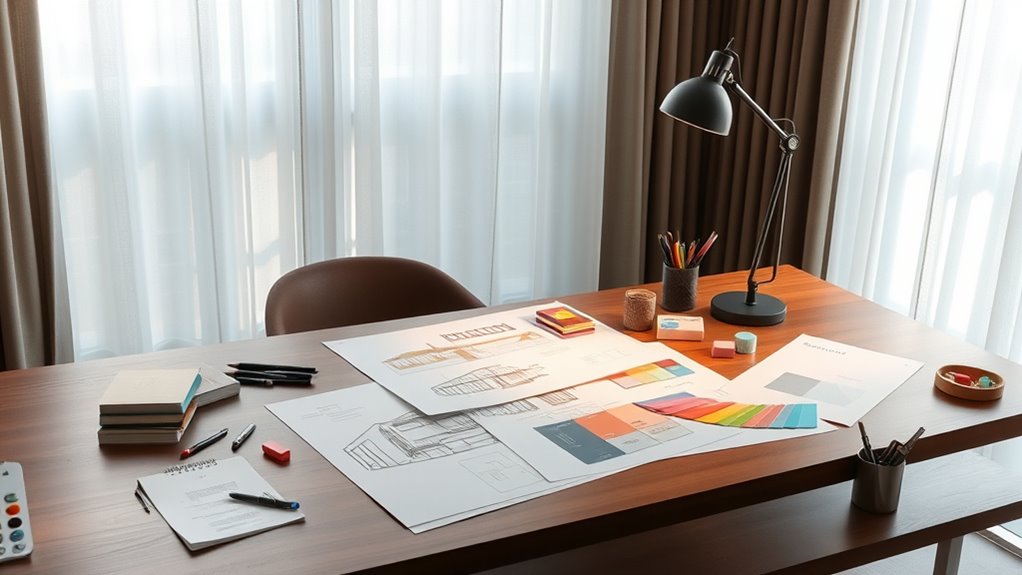
Designing for flexibility and layering guarantees your lighting setup can adapt to changing needs throughout the day. Use a combination of light sources with adjustable color temperature and dimming controls to create versatile environments. Layer lighting by combining ambient, task, and accent lights to suit different activities and moods. Incorporate fixtures that allow easy adjustments, ensuring seamless progression between settings. Here’s a simple idea matrix:
| Idea | Implementation |
|---|---|
| Variable Color Temperature | Use tunable LED fixtures for different times of day |
| Dimming Controls | Install dimmers on all key light sources |
| Layered Lighting Approach | Combine ambient, task, and accent lighting |
| Flexibility in Placement | Use movable fixtures or adjustable mounts |
This approach keeps your lighting adaptable, functional, and visually pleasing. Additionally, selecting fixtures compatible with different control systems can enhance your ability to fine-tune the ambiance effortlessly.
Implementing Energy-Efficient Solutions

Implementing energy-efficient solutions is essential for reducing your lighting system’s environmental impact and lowering operational costs. To maximize benefits, focus on these strategies:
- Choose LED fixtures: They offer superior fixture durability and markedly improve energy savings over traditional lighting.
- Install smart controls: Motion sensors and dimmers optimize power use based on occupancy and natural light, reducing waste.
- Opt for quality materials: Durable fixtures reduce replacement frequency, ensuring long-term savings and consistent performance.
Troubleshooting Common Ambient Lighting Challenges

Despite careful planning, ambient lighting setups can still face common challenges that hinder their effectiveness. One frequent issue is inconsistent color temperature, which can create a mismatched or harsh atmosphere. To fix this, check your fixtures’ bulbs and verify they all match in warmth or coolness. Fixture placement also plays a vital role; improper positioning can cause uneven lighting or glare. Make sure your fixtures are spaced evenly and directed where needed, avoiding areas that create shadows or overly bright spots. If your space feels unbalanced, adjust the angles or swap out fixtures with adjustable heads. Remember, small tweaks to color temperature and fixture placement can dramatically improve your ambient lighting’s overall harmony and comfort.
Maintaining and Adjusting Your Lighting Plan
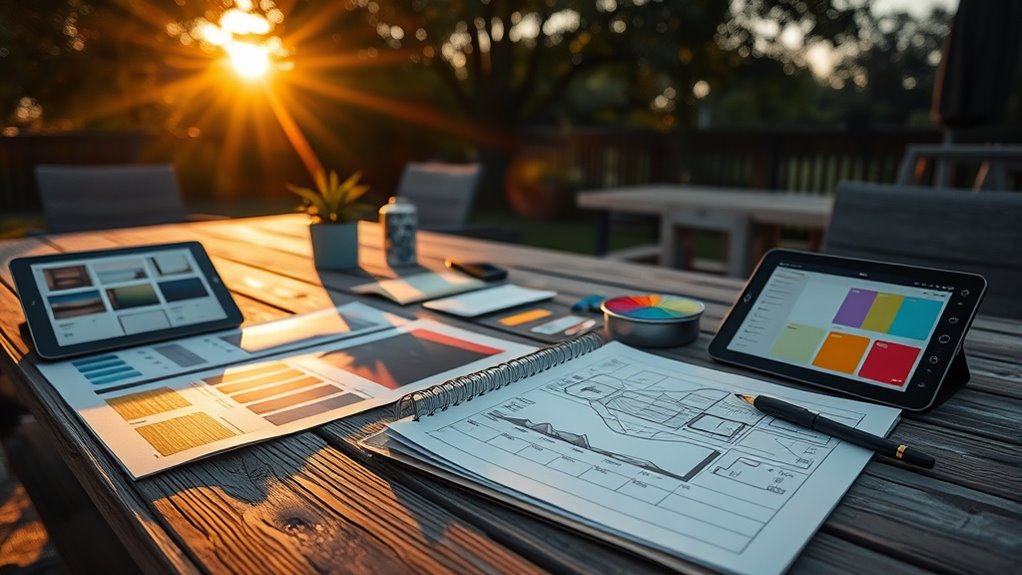
To guarantee your ambient lighting continues to perform effectively over time, regular maintenance and adjustments are essential. Over time, fixture maintenance becomes vital to ensure bulbs are functioning properly and to prevent flickering. Additionally, periodically review your color temperature settings to maintain the desired ambiance. Here are three key steps:
Regularly maintain fixtures and review settings to keep your ambient lighting inviting and effective.
- Check and replace any faulty fixtures or bulbs to ensure consistent light quality.
- Adjust color temperature settings if your environment’s mood or purpose changes.
- Clean fixtures regularly to prevent dust buildup that can dim light output.
These simple actions keep your lighting plan aligned with your needs, enhancing comfort and energy efficiency. Maintaining and adjusting your plan ensures your ambient environment remains inviting and functional.
Frequently Asked Questions
How Can I Measure the Effectiveness of My Ambient Lighting Plan?
To gauge your ambient lighting plan’s effectiveness, focus on measurement metrics like light levels, energy consumption, and user satisfaction. Collect data through surveys, light meters, and energy monitors regularly. Analyze this data to see if your lighting meets your goals for comfort, efficiency, and ambiance. Adjust your plan based on these insights and continue tracking to guarantee ongoing improvement and ideal results.
What Are the Best Practices for Integrating Smart Lighting Controls?
You should prioritize lighting automation and user customization to seamlessly integrate smart lighting controls. Set up automation schedules based on time of day or occupancy to optimize energy use, and allow users to personalize lighting levels via apps or switches. Regularly test and update your system to guarantee smooth operation, and educate users on how to customize settings for their comfort. This approach maximizes efficiency and enhances user experience.
How Do I Adapt Lighting Strategies for Different Seasons?
Think of seasonal lighting as a dance that changes with the music. You adapt your lighting strategies by adjusting your ambient light and using adaptive design techniques to match the seasons. In winter, boost warm, cozy lighting, while in summer, maximize natural light and cooler tones. Incorporate smart controls to effortlessly switch settings, ensuring your space remains inviting all year round, like a chameleon blending into its surroundings.
Can Ambient Lighting Improve Mood and Productivity?
Yes, ambient lighting can boost your mood and productivity by leveraging color psychology and natural light. You can use warm tones to create a cozy, inviting atmosphere or cooler tones to promote focus. Incorporate natural light whenever possible, as it’s proven to improve well-being. Strategic placement of ambient lights, combined with color choices, helps you feel more energized and motivated throughout your day.
What Safety Considerations Should I Keep in Mind When Planning Lighting?
When planning lighting, you should prioritize safety by carefully selecting lighting fixtures that are durable, appropriate for the environment, and compliant with safety standards. Always include emergency lighting to ensure visibility during power outages. Check that fixtures are properly installed, grounded, and positioned to prevent accidents. Regular maintenance is essential to keep emergency lighting functional, and avoid overloading circuits to reduce fire hazards, guaranteeing a safe and reliable lighting setup.
Conclusion
Think of your space’s lighting plan as a symphony—you’re the conductor blending natural and artificial sounds to create harmony. When you assess your needs, choose fixtures wisely, and remain flexible, you craft an environment that feels just right. Remember, even the best compositions require adjustments. Like tuning an instrument, your lighting plan evolves—so stay attentive, and your space will glow with purpose and comfort, turning everyday moments into a beautifully lit experience.

